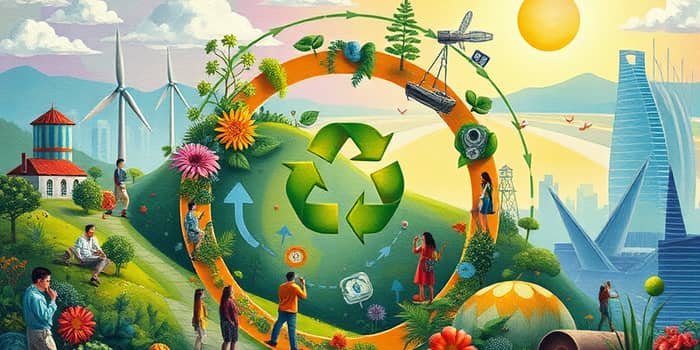
The modern economic system faces unprecedented challenges: resource scarcity, climate change, and mounting waste. Shifting from a linear “take-make-waste” approach to a circular model requires more than technological innovation—it demands innovative finance solutions that are regenerative by design. This article explores how financial instruments, policy frameworks, and strategic investments can catalyze a global transition toward a truly circular economy.
At its core, the circular economy emphasizes sharing, leasing, reusing, repairing, refurbishing, and recycling to keep products and materials in use as long as possible. It stands in stark contrast to the traditional linear model, which depletes natural resources and generates vast quantities of waste.
True regeneration goes beyond recycling: it actively restores ecosystems, returns nutrients to the soil, and fosters biodiversity. By designing systems that eliminate pollution and waste, the circular economy aims to regenerate natural systems rather than merely reduce harm.
Circular economy finance comprises any financial instrument—debt, equity, bonds, loans, or blended finance mechanisms—used exclusively to support companies or projects that embody circular principles. Its purpose is to mobilize capital toward innovations that close material loops, design out waste, and generate multifaceted value.
By directing funds to initiatives like product-as-a-service models, remanufacturing operations, and waste-to-resource technologies, circular economy finance aligns environmental, social, and economic objectives, creating sustainable and resilient business models.
Nearly half of global greenhouse gas emissions derive from the extraction, production, and use of products, food, and land-management practices. Addressing this requires shifting key sectors to circular strategies.
These figures demonstrate the urgent need for transformative finance to drive circular solutions at scale.
Since 2019, investors and institutions have channeled approximately USD 350 billion into circular economy initiatives. This rapid expansion reflects growing recognition of circular finance’s potential.
Key metrics illustrate the momentum:
These asset classes—equity funds, green and circular bonds, blended finance, and corporate loans—provide investors with diverse opportunities to back circular ventures and share in long-term value creation.
A variety of tailored instruments drive capital toward circular projects. Understanding their characteristics helps stakeholders allocate resources effectively:
Voluntary guidelines and emerging taxonomies—such as the Dutch circular finance standards and IFC’s Harmonized Circular Economy Finance Guidelines—are crucial for defining eligibility and enhancing transparency.
Circular finance can transform industries by encouraging design innovation and resource efficiency. Key sectors include:
Case studies—such as Dutch banks collaborating on circular finance guidelines and IFC’s scaling of circular solutions in emerging markets—show the breadth of possible applications.
Government action and international agreements play pivotal roles in scaling circular investments. Notable policy drivers include:
The EU Circular Economy Action Plan and European Parliament regulations establish mandatory recycling targets, product-design standards, and incentives for circular business models.
At COP28, negotiators integrated circular economy principles into climate outcomes, signaling global consensus on the approach’s importance.
National and regional initiatives across Asia, Africa, and the Americas are developing action plans to mobilize public and private capital for circular projects.
Despite growing momentum, several obstacles impede faster growth:
Lack of Common Standards: Fragmented definitions and inconsistent measurement hinder comparability.
Early-Stage Risk: Many circular innovations remain pre-commercial, requiring concessional finance or guarantees to attract private investors.
Scalability: Local or niche projects often struggle to replicate globally without robust financing platforms and partnerships.
Investing in circular finance yields profound returns across environmental, economic, and social dimensions:
Environmental: Significant emissions reductions, waste minimization, resource conservation, and biodiversity enhancement.
Economic: New revenue streams, cost savings, risk mitigation, and unlocked multi-trillion-dollar investment opportunities.
Social: Job creation in remanufacturing, repair, logistics, and emerging circular enterprises, fostering inclusive growth.
Looking ahead, several trends will shape circular economy finance:
Digital Platforms and Traceability: Blockchain and IoT solutions will enhance materials tracking and impact reporting.
Expanding Finance Instruments: Continued growth in circular bonds and equity funds as investors seek resilient, sustainable returns.
Strategic Role in Net-Zero: Circular finance will be indispensable for meeting net-zero targets, bolstering supply-chain resilience, and fostering long-term sustainable growth.
The transition to a circular economy represents one of the most transformative opportunities of our time. By deploying innovative financial instruments and fostering enabling policies, we can fund a regenerative future that delivers environmental restoration, economic prosperity, and social well-being.
Mobilizing additional capital—particularly through blended finance mechanisms and standardized guidelines—will be critical for scaling circular projects worldwide. Stakeholders across sectors must collaborate to overcome barriers, align on standards, and share best practices.
Ultimately, circular economy finance is not just about mitigating risk; it is about unlocking a new paradigm of growth that honors planetary boundaries, regenerates ecosystems, and secures a thriving future for generations to come.
References





